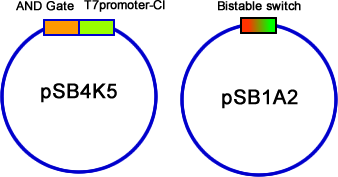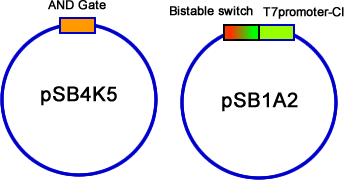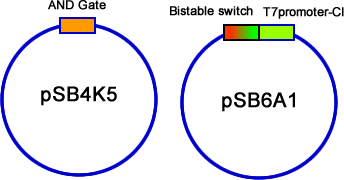Team:PKU Beijing/Project/Assemble
From 2009.igem.org
(→First Stage Assembly) |
(→Second Stage Assembly (In Process)) |
||
| Line 59: | Line 59: | ||
==='''Second Stage Assembly (In Process)'''=== | ==='''Second Stage Assembly (In Process)'''=== | ||
| + | |||
| + | ===='''Design'''==== | ||
| + | |||
| + | After the first stage assembly was finished, we designed the further step based on what we have. It is shown in the result section of the first stage assembly that the three plasmids assembly turn out to work. We designed the second stage assembly as below: | ||
| + | |||
| + | First the OR Gate-GFP module can be put on the same plasmid of the bistable switch, which has a relatively higher copy origin so that the output can be easier visualized. Actually, there is another consideration for this kind of design. Because the PhiR73 delta system is used by 2007 Cambridge team to make an amplifier, placing the PhiR73 delta(with an amber mutation) on a relatively lower copy plasmid than the output module can gain more chance that the OR gate is activated to the a similar extent when exposed to PhiR73 delta as when directly activated by salicylate. (Detailed description is on the [[OR Gate and Output page]]). | ||
| + | |||
| + | And then, the PhiR73 delta expression set, which is controlled by CI434 repressible CI activatable promoter is placed on the pSB3T3 plasmid together with the T7 promoter-CI construct. In order to reduce influence on each other, we can use PCR strategy to reverse the PhiR73 delta expression set. (Click Here for more Information of the PCR Reversing Strategy). We designed the PhiR73 delta expression set on a medium copy plasmid, because the reason we mentioned above, and another reason is that the SupD expression set has a lower copy than the PhiR73 delta expression set. As our [[earlier experience]] tell us, supD is much easier to be leaky, while the other half of the AND Gate can be controled by adjusting its rbs. SupD on a lower copy plasmid gives us more chance. | ||
| + | |||
| + | The final assembly introduced another GFP reporter (the OR Gate - GFP set), so we want to delete the GFP gene from the bistable device, while the RFP gene is kept to track the change of memory state. | ||
| + | |||
| + | Actually, our second stage assembly can be viewed as the construction of an AND Gate: | ||
| + | |||
| + | |||
{{PKU_Beijing/Foot}} | {{PKU_Beijing/Foot}} | ||
Revision as of 04:13, 16 October 2009
|
|||||||||||||
|
|||||||||||||
 "
"

















